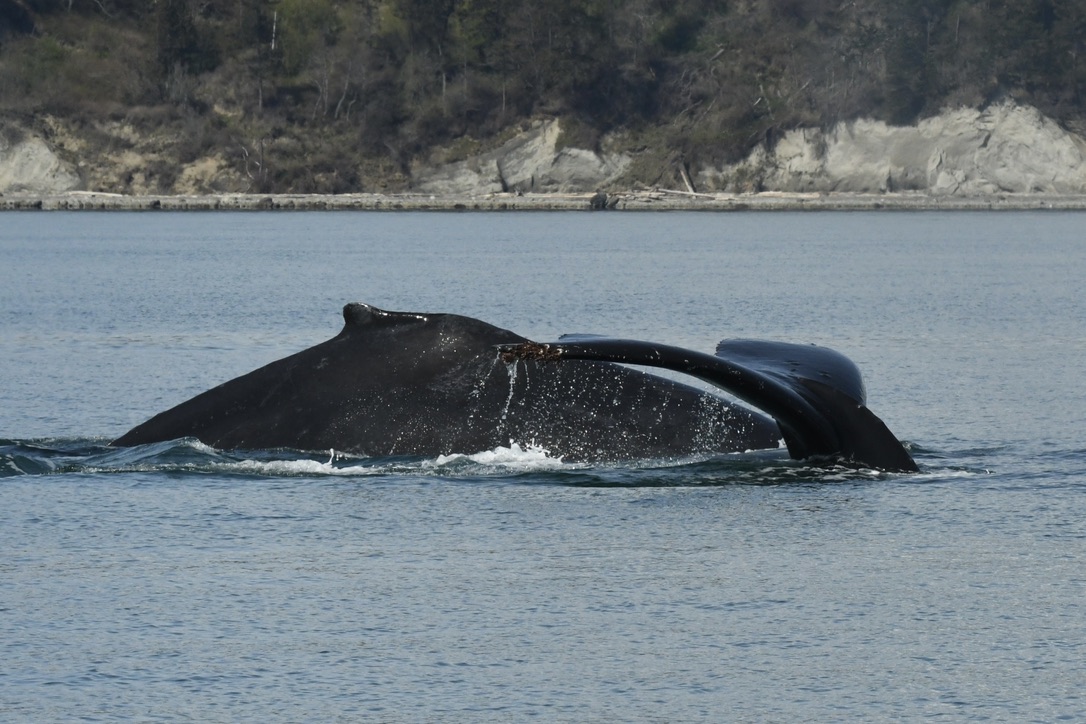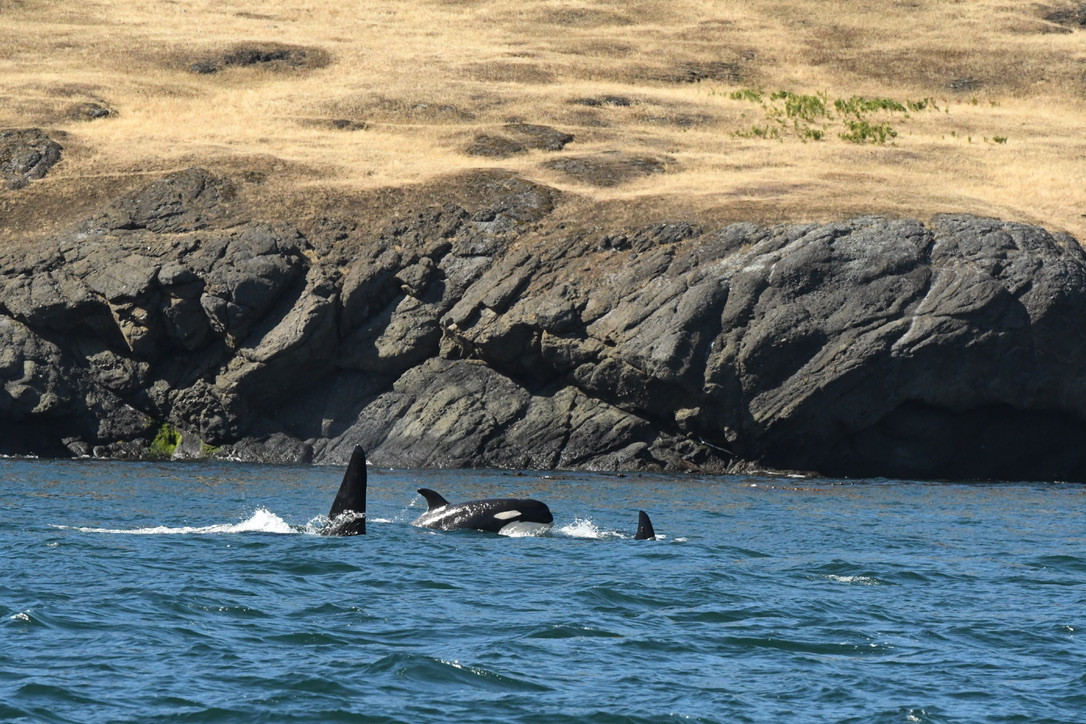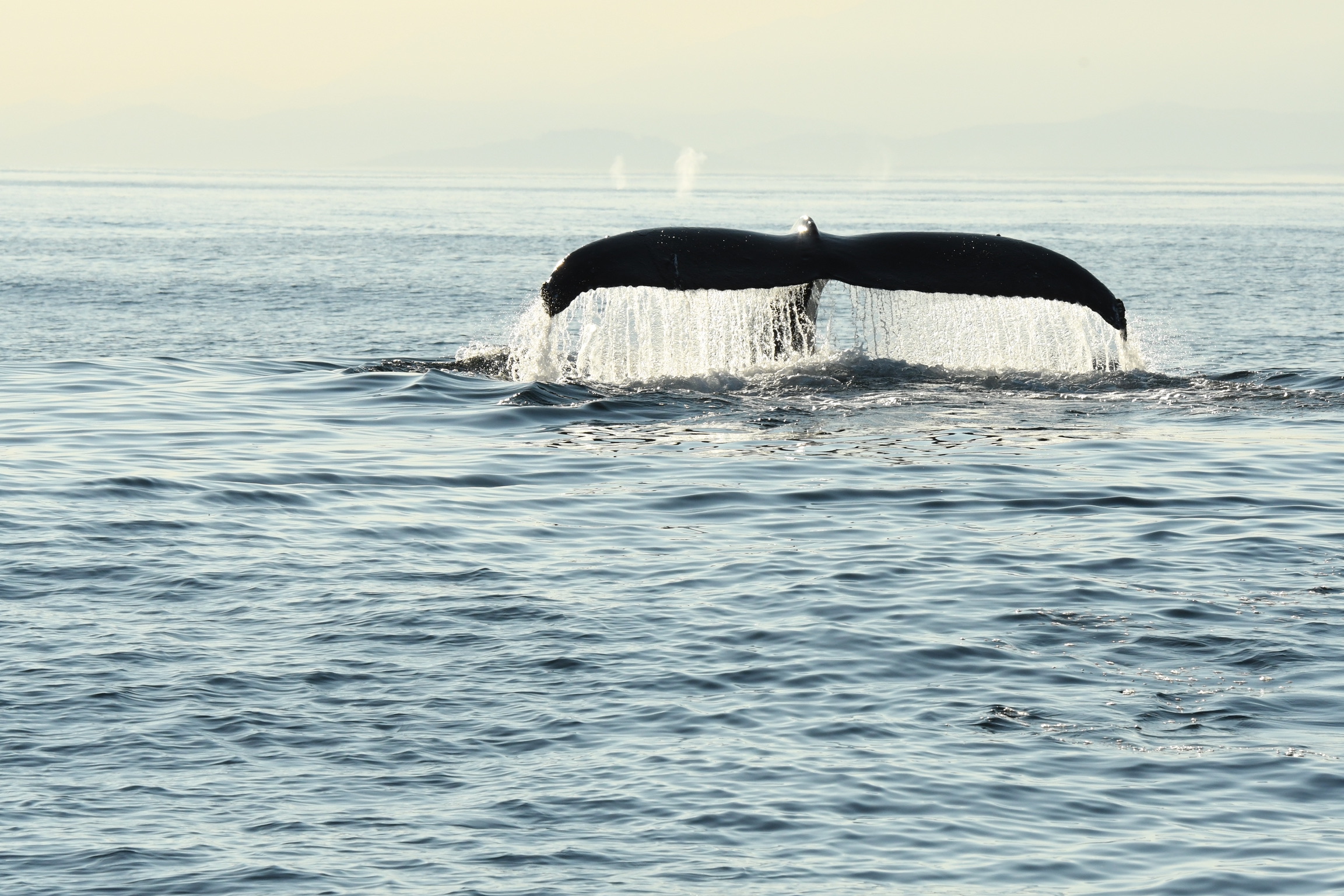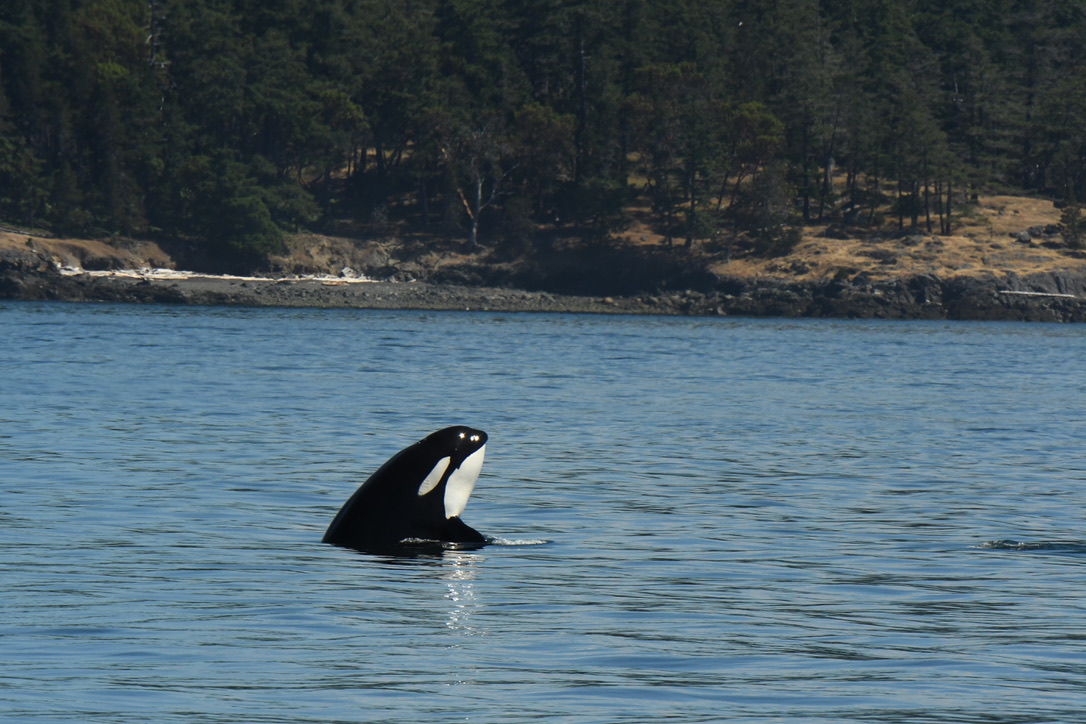Whale Vocalizations
Every moment we witness whales coming to the surface– just brushing the edge of the world we know– is absolutely breathtaking! We wouldn’t have such a fascination with whale watching if it weren’t for these profound moments. And when we are lucky enough to share in their playful and celebratory behaviors such as breaching, tail/ pectoral fin slaps, spyhops, etc. we feel the thrill all the more. Yet there is a whole world of whales that exists beneath the surface and beyond what we can imagine or even fully comprehend.
Part of this world is more than what we can “watch.” Taking some time to listen to these enormous creatures is equally as mesmerizing. Many whales produce unique “vocalizations” that typically consist of a series of clicks, grunts, moans, and whistles among many others in a wide range of high and low frequencies. Many sounds are at such extreme frequencies that they are not even detectable by the human ear. Modern researches have made use of hydrophones which have the ability to capture and amplify underwater sounds so that we can take a listen on the surface. This opens our minds to ponder on what these sounds mean and their purposes.

Sound Underwater
Imagine you are swimming in the ocean with a friend and you’re not wearing any goggles. You might be the type that can open your eyes underwater, but even with your eyes open your vision is blurred and the water is a little murky. Your friend is very good at holding their breath and diving down, but you are trying to get their attention and can’t reach them. What do you do? My guess is that you make a fool of yourself either with big splashes, or creating loud hums or squeals underwater. But this is not so foolish– we rely so much on body language and visual senses to comprehend our surroundings above the surface, but underwater this becomes less reliable and our sense of sound takes precedence. This is the world that whales live in. Known to have poor eyesight, whales use sound and vibrations to interpret the world around them and communicate amongst other whales. Not to mention sound travels about four times faster underwater than through air!
Odontocetes (toothed-whales), such as our orcas, use two different methods to produce sound. Lower frequency sounds are produced moving air from their lungs through their larynx in their throat. Most of the sounds they create however, especially high frequency sounds, actually come from a system of air sacs located near their blowhole. The soft tissues around these sacs vibrate as air passes through and the whales are able to manipulate these vibrations into a variety of sounds through the shape of their “melon” (fatty sac in the forehead region.) Orcas are known to “echolocate” with a series of high frequency clicks which can travel to distances up to 10 miles. These clicks bounce off of other objects in the water such as land, ocean floor, boats, other mammals, and prey, returning vibrations that the orca is able to decipher in order to identify the objects, navigate, and hunt. Pulsed calls and whistles are often heard during social interactions and are thought to even contain different dialects that the orcas use to communicate. Take a listen to some common orca whale sounds here!

Mysticetes (baleen whales), including our humpback whales, only use the larynx to produce sound. Still a bit of a puzzle as to how the sound is generated, scientists believe that when the air moves from the lungs, it passes through a U-shaped fold of soft tissue and fills what is known as the “laryngeal sacs.” This movement of air causes the tissue to vibrate and thus reverberate through the laryngeal sacs, producing a hollow-like sound that vibrates out into the water through the ventral throat pleats. This sound system is even more unique in that the whales don’t exhale while they make sounds the way humans do– the air is actually recycled back into the lungs to start the process over again. Most of the sounds generated by baleen whales are at fairly low frequencies and are thought to be able to travel thousands of miles (some studies suggest up to 10,000 miles!) Many of these sounds are likely used for communication, or as a “feeding call” and are heard in short spurts. What is extra fascinating though is the series of sounds that these whales string together into patterns, “phrases”, and “themes”, that are most comparable to a human song.
Humpback Songs
One of the most extraordinary vocalizations is the song of the humpback whale. Perhaps it is so noteworthy (no pun intended) due to the length and complexity. Or possibly because the way each song evolves throughout a population. But what makes it even more alluring is the mystery behind the purpose of the song and our determination to uncover this unclear piece in the humpback whale world. As humans, we think of songs as expressions. Music is an art, so in a sense we’ve started to anthropomorphize this entrancing and eerie melody into the whale’s way of expressing emotion. Whether that is the case or not, I find it beautiful to imagine it this way! Composers of the ocean!
What We Do Know
Though humpbacks can vocalize at any time, these songs in particular are partial to males and sung primarily during breeding season. Typically the male will position himself at an angle with his snout pointing down and his fluke just a few feet under the surface. Sometimes they will sing solo, and sometimes another male or more will join them. Picture an underwater gentlemen’s choir! What makes these sounds into songs is the fact that the pieces of sound come in patterns that repeat themselves as phrases the same way we string together a series of notes and repeat through verses and chorus. As the whales sing together, occasionally a segment of the song will be manipulated with a new phrase, but will keep to the same overarching theme. The other whales then will learn this adapted piece and carry it along the next time they sing. Whales in one geographic region will all be singing essentially the same song while whales in another region have their own unique song. Researchers have even determined that parts or patterns of these songs have existed throughout a population for generations and been passed along, adapted, and translated to a widespread area within their geographic region. Remix anyone?! What’s even more is the dedication devoted to these songs by their singers– some songs will go on for 30 minutes to 1 hour. But many have been recorded for much longer with the longest at 22 hours!!
The Mystery and Human Theories
Now who the heck are these maistros performing for, and what is the reason behind the song? While there are some valid theories, scientists are still not completely sure of the answer in regards to the song’s purpose. Maybe they’re just singing to see who is in the neighborhood or share their new location. The most popular theory is that the song is used in relation to attracting females. This checks out as a possibility due to the correlation with the songs being sung during breeding season. What doesn’t quite check off is that there isn’t any clear evidence that females are drawn to the males while they are singing. To a similar effect, the songs could be seen as a territorial demonstration of superiority over other males. Perhaps to establish a pecking order amongst the mating individuals based on the quality of their song. Recent studies have also brought about discoveries of humpbacks occasionally singing in their feeding grounds. Typically, this is still noted to occur close to breeding season, during their migration and upon arrival to their feeding waters, or at the tail end of feeding season before they head to their breeding waters. Since the most common understanding is that the whales song is related to mating, it is a wonder as to why they may sing in their feeding grounds as well. Some speculate that they could be practicing in order to perfect their masterpiece before it is time to perform. Or maybe they’re taking advantage of an extra opportunity to impress females or intimidate males. So many questions and curiosities with these magnificent creatures! Listen to one of these beautiful humpback whale songs here!

When Sound is Life
Though many aspects of the sounds of whales have yet to be or may never be unveiled, it is absolutely evident that sounds are crucial to the daily life and survival of these species. Without these series of sounds, it would be much more difficult for whales to navigate, find prey, communicate, and mate. As the oceans become noisier with boat traffic, underwater construction, military sonar, and oil drilling, the ability for whales to produce and receive sounds effectively is becoming more challenging. It’s like trying to have an important conversation with someone while standing next to a jackhammer at a construction zone. Not easy to talk over the noise and you may have to find somewhere else to better communicate. Keep in mind the speed and distance that sound can travel underwater. Sometimes this can be forcing the whales away from desirable feeding grounds and interfere with the sound waves that they produce or receive back when echolocating. Heavy shipping traffic has also reduced the range in which whales can be heard, and some humpbacks won’t sing if they are within 100-125 miles of fast-moving ships.
What Can We Do
While human interference with whales’ natural day to day life is disconcerting, it’s essentially unavoidable at this stage. We can’t simply remove all vessels and infrastructure from the oceans. But we can mitigate and reduce our noise pollution through conscientious efforts and modern adaptations. Traveling by boat mindfully and maintaining space and reduced speeds in the presence of whales is highly regulated within the Salish Sea and our cruising grounds. Researchers are also investigating ways to stifle or muffle the sounds of offshore construction and drilling. And we are even on the brink of launching hydrogen powered vessels as a possible resolution for noise reduction and cleaner energy.
Ultimately, in our whale world, we want to do our best to preserve the peace of the wild waters. The sea is their home and it is within our power and our responsibility to assure the whales through our positive actions that these waters are a place they can be safe and can thrive!
References
BBC: Science Focus 2023, How humpback whales communicate through a hidden global network of song, Our Media Ltd., accessed on July 3, 2023, https://www.sciencefocus.com/nature/whale-song/
NOAA, Unravelling Mysteries of Humpback Whale Song, National Marine Sanctuaries, accessed on July 3, 2023, https://sanctuaries.noaa.gov/news/sep22/mysteries-of-humpback-whale-song.html
PBS 2023, Song of the Sea: Season 18; Episode 6- 2001, accessed on July 3, 2023, https://www.pbs.org/wnet/nature/humpback-whales-song-of-the-sea/2874/#:~:text=The%20male%20may%20repeat%20the,songs%20emerge%20every%20few%20years.
Wikepedia, Whale Vocalization, accessed on July 3, 2023, https://en.wikipedia.org/wiki/Whale_vocalization
Discovery of Sound in the Sea 2002-2021, How do marine mammals produce sound?, The University of Rhode Island, accessed on July 3, 2023, https://dosits.org/animals/sound-production/how-do-marine-mammals-produce-sounds/#:~:text=Baleen%20whales%20also%20use%20a,air%20sacs%20near%20their%20blowhole.
NOAA, Why do whales make sounds?, accessed on July 3, 2023, https://oceanservice.noaa.gov/facts/whalesounds.html#:~:text=Whales%20are%20very%20social%20creatures,navigation%20and%20identifying%20physical%20surroundings.
TED Ed, Why do whales sing? – Stephanie Sardelis, accessed on July 3, 2023, https://www.youtube.com/watch?v=7Xr9BYhlceA


